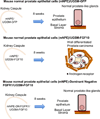Targeting fibroblast growth factor pathways in prostate cancer
- PMID: 24052019
- PMCID: PMC3926427
- DOI: 10.1158/1078-0432.CCR-13-1550
Targeting fibroblast growth factor pathways in prostate cancer
Abstract
Advanced prostate cancer carries a poor prognosis and novel therapies are needed. Research has focused on identifying mechanisms that promote angiogenesis and cellular proliferation during prostate cancer progression from the primary tumor to bone-the principal site of prostate cancer metastases. One candidate pathway is the fibroblast growth factor (FGF) axis. Aberrant expression of FGF ligands and FGF receptors leads to constitutive activation of multiple downstream pathways involved in prostate cancer progression including mitogen-activated protein kinase, phosphoinositide 3-kinase, and phospholipase Cγ. The involvement of FGF pathways in multiple mechanisms relevant to prostate tumorigenesis provides a rationale for the therapeutic blockade of this pathway, and two small-molecule tyrosine kinase inhibitors-dovitinib and nintedanib-are currently in phase II clinical development for advanced prostate cancer. Preliminary results from these trials suggest that FGF pathway inhibition represents a promising new strategy to treat castrate-resistant disease.
Conflict of interest statement
Conflict of Interest Information: PGC has served on a Novartis-sponsored advisory board for Dovitnib but did not receive any financial compensation.
Figures





Similar articles
-
The role of fibroblast growth factors and their receptors in prostate cancer.Endocr Relat Cancer. 2004 Dec;11(4):709-24. doi: 10.1677/erc.1.00535. Endocr Relat Cancer. 2004. PMID: 15613447 Review.
-
Targeting the fibroblast growth factor receptor family in cancer.Cancer Treat Rev. 2016 May;46:51-62. doi: 10.1016/j.ctrv.2016.03.015. Epub 2016 Apr 12. Cancer Treat Rev. 2016. PMID: 27109926 Review.
-
Clinical advances and challenges in targeting FGF/FGFR signaling in lung cancer.Mol Cancer. 2024 Nov 15;23(1):256. doi: 10.1186/s12943-024-02167-9. Mol Cancer. 2024. PMID: 39543657 Free PMC article. Review.
-
Pharmacologically targeting the myristoylation of the scaffold protein FRS2α inhibits FGF/FGFR-mediated oncogenic signaling and tumor progression.J Biol Chem. 2018 Apr 27;293(17):6434-6448. doi: 10.1074/jbc.RA117.000940. Epub 2018 Mar 14. J Biol Chem. 2018. PMID: 29540482 Free PMC article.
-
The potential of fibroblast growth factor/fibroblast growth factor receptor signaling as a therapeutic target in tumor angiogenesis.Expert Opin Ther Targets. 2015;19(10):1361-77. doi: 10.1517/14728222.2015.1062475. Epub 2015 Jun 30. Expert Opin Ther Targets. 2015. PMID: 26125971 Review.
Cited by
-
Paracrine Fibroblast Growth Factor Initiates Oncogenic Synergy with Epithelial FGFR/Src Transformation in Prostate Tumor Progression.Neoplasia. 2018 Mar;20(3):233-243. doi: 10.1016/j.neo.2018.01.006. Epub 2018 Feb 11. Neoplasia. 2018. PMID: 29444487 Free PMC article.
-
Prognostic Significance and Functional Role of CEP57 in Prostate Cancer.Transl Oncol. 2015 Dec;8(6):487-96. doi: 10.1016/j.tranon.2015.11.004. Transl Oncol. 2015. PMID: 26692530 Free PMC article.
-
Characterization of FGFR signaling in prostate cancer stem cells and inhibition via TKI treatment.Oncotarget. 2021 Jan 5;12(1):22-36. doi: 10.18632/oncotarget.27859. eCollection 2021 Jan 5. Oncotarget. 2021. PMID: 33456711 Free PMC article.
-
Oncologic outcomes with and without amniotic membranes in robotic-assisted radical prostatectomy: A propensity score matched analysis.Asian J Urol. 2024 Jan;11(1):19-25. doi: 10.1016/j.ajur.2022.05.004. Epub 2022 Jul 3. Asian J Urol. 2024. PMID: 38312822 Free PMC article.
-
Nintedanib inhibits growth of human prostate carcinoma cells by modulating both cell cycle and angiogenesis regulators.Sci Rep. 2018 Jun 22;8(1):9540. doi: 10.1038/s41598-018-27831-1. Sci Rep. 2018. PMID: 29934570 Free PMC article.
References
-
- American, Cancer, Society. Cancer facts and figures 2012. 2012
-
- Kirby M, Hirst C, Crawford ED. Characterising the castration-resistant prostate cancer population: a systematic review. Int J Clin Pract. 2011;65:1180–1192. - PubMed
-
- Agarwal N, Sonpavde G, Sternberg CN. Novel molecular targets for the therapy of castration-resistant prostate cancer. Eur Urol. 2012;61:950–960. - PubMed
-
- Daniele G, Corral J, Molife LR, de Bono JS. FGF receptor inhibitors: role in cancer therapy. Curr Oncol Rep. 2012;14:111–119. - PubMed
Publication types
MeSH terms
Substances
Grants and funding
LinkOut - more resources
Full Text Sources
Other Literature Sources
Medical

